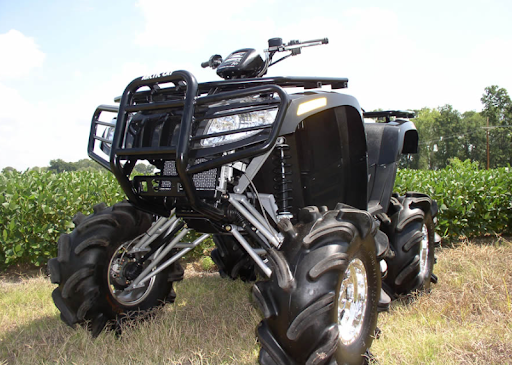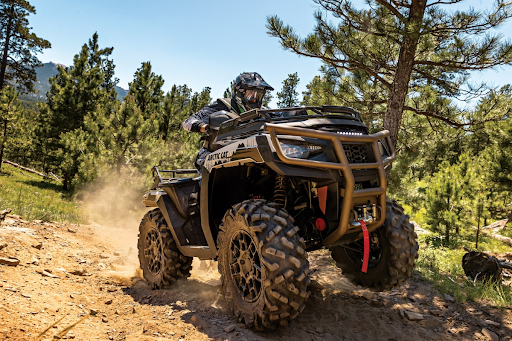Dominate Any Terrain: A Guide to Arctic Cat ATV Axles
Class-leading ground clearance, reinforced chassis, uprated suspension, and steering components are just some features that pit all Arctic Cat ATVs and side-by-sides way above the competition. Throw in reworked radiators, quieter clutches and reduced engine vibrations for reduced noise, better engine cooling and more ride comfort.
For outright performance on challenging terrain, go with the 130hp Wildcat XX Black Hills Edition (with 32-inch trail tires and lower gearing as standard), the Alterra Mud Pro with selectable front diff for laid-back and effortless mudbogging, or any of the Prowler models if you want an all-round quad ready for anything you throw at it.
The entire model lineup is prepped for more performance, increased reliability and durability. Arctic Cat has reworked the transmission and axles, added more power, smoothed out throttle response, optioned lift kits and strengthened A-arms for improved wheel articulation on harder obstacles. These are quads meant to be abused regardless of where and how you ride. For longer trail fun, consider the wide options and parts list, and have a few spares if or when something goes wrong. Basic spares, like front and rear Arctic Cat ATV axles, won’t leave you in the middle of nowhere, nor risk costly repairs.
What Axles Do

Axles transfer the power from the engines through the transmission and onto the wheels. They also complement the suspension by keeping the machines glued to the ground for better traction and stability and by steering for basic maneuvers like turns. Bent, busted or broken axles or damaged or dry CV joints won’t get you anywhere. These are some of the first components that fail on any machine and across all ATVs and side-by-side brands.
Stock axles may be good for leisurely riding, but all that torque and power from harder riding will eventually lead to unwanted problems. Arctic Cat does stock axles better than anyone in the business, but these too will eventually need replacing. Heat, friction, dust and dirt from all that fun you’re having will mean that at some point you’ll be looking at new front and rear axle pairs.
Signs of Bad Axles

Factory ATV and UTV axles can last anywhere between 5 and 5000 miles. This depends on how and where you ride and whether you’re more eager on the throttle. Early Arctic Cat models were known to have subpar axles that failed prematurely, even on leisurely and infrequent rides.
Improvements in subsequent models have meant more carefree riding, with fewer durability issues. Still, with bigger engines, more torque, and a chassis setup geared for off-roading thrills, the parts will eventually give way to general wear and tear. Add to this increased friction and heat due to lost grease from torn or ruptured boots, and power loss from faulty joints, and you end up with seized, bent or snapped axle shafts. Problems can come on gradually, or abruptly, and this is when a spare comes in handy. Obvious signs to look out for are:
- Popping and clicking sounds in turns – if you’re having trouble turning, and maneuvers are accompanied by popping or clicking sounds, time to inspect the boots, joints and shaft for wear and possible damage.
- Clunking noises when on the gas – jolty acceleration points either to faulty clutches, worn drive belts, or axles that can’t get power to the wheels. You’ll hear louder clunks when in lower gears, and when the transmission begins to shift up or down. Attempts at reversing are also followed up with louder sounds.
- Pronounced vibrations – if the handlebars or steering wheel on your Cat are all about the place, look into the condition of the CV joints. Damaged, dry or fried bearings are some of the most common culprits.
- Humming and buzzing sounds – lost lubrication means not enough grease in the bearings—are typical signs. This happens due to ruptures and tears in the CV boots, for instance when scaping against rocks or branches.
What to Use as Replacements
You might be lucky enough to reach home or the garage and get any issues sorted out. But you also risk damaging the transmission, snapping the drive belt, and weakening suspension parts. Replacement Arctic Cat ATV axles are easy to find, both for current and previous models. If you own an older quad (the 400, 500, 650 and 700 Cats, or the TBX, TRV and early Prowler models), today’s aftermarket axles are a serious performance upgrade over what was offered as a factory kit.
While there are dozens of brands to choose from, you’ll want a quality build, heat-treated parts for longevity, more in the way of shaft thickness, and parts machined to tighter tolerances. The tiered lineups differ in the machines they’re meant for and the end price. Standard-duty axles for something like the Alterra revolve around thicker 5140 heat-treated steel shafts, more heft in the boots for added puncture resistance, industrial bearings for smooth rolling, and machined CV joints to get all the power down. As mentioned, if you’re using these on older machines, you’ll also notice better wheel articulation with increased angles in the joints. This reduces the risk of overheating, even with fitted lift kits.
Bigger quads like the Wildcat and the Prowler will benefit from extreme-duty axles to deal with the added torque and weight. There’s more attention to materials and production processes, with treated 4340 Chromoly steel for higher heat and fatigue resistance, thicker heat and puncture-resistant neoprene or thermoplastic elastomer boots to keep out water, mud and any contaminants that can corrode and seize internal parts, and induction-treated industrial bearings to deal with radial and axial stress.
Moreover, the CV joints are CNC machined for higher precision with connecting splines and for lasting durability and control when riding in tougher terrain, They’re additionally lubricated with high-pressure Moly grease for reduced friction and wear. The details and changes may be subtle, but they add up.
Arctic Cat owners can choose single left or right axles for the front or rear. Or save some cash and go with matching pairs. The latter option additionally provides a more poised ride, with balanced power delivery. Shop for aftermarket Arctic Cat axles from a range of brands and in varied price brackets, or opt for OEM axles at considerably higher prices. Just keep in mind your model and production year to ensure they fit.



